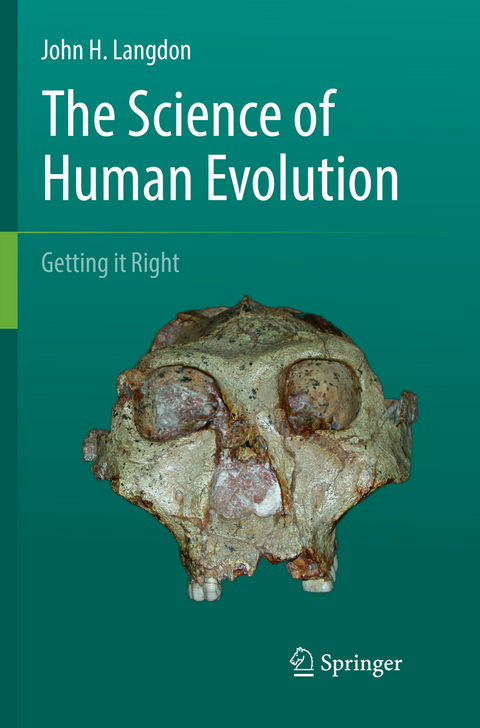
The Science of Human Evolution
Springer International Publishing (Verlag)
978-3-319-82389-8 (ISBN)
John H. Langdon, Ph.D.Professor of Biology and AnthropologyUniversity of Indianapolis Current research interests include hominin and hominoid paleontology and evolution, history and development of paleoanthropology, origins of human bipedalism, evolution of human behavior, historical demography, human biology, and history and process of the natural sciences.
Introduction: The Method of Science.- Case Study 1. The Darwinian Paradigm: An Evolving World View.- Case Study 2. Proving Prehistory: William Pengelly and Scientific Excavation.- Case Study 3. Testing Predictions: Eugene Dubois and the Missing Link.- Case Study 4. Self-Correcting Science: The Piltdown Forgery.- Case Study 5. Checking the Time: Geological Dating at Olduvai Gorge.- Case Study 6. Quantifying Evolution: Morris Goodman and Molecular Phylogeny.- Case Study 7. Reinterpreting Ramapithecus: Reconciling Fossils and Molecules.- Case Study 8. Taming the Killer Ape: The Science of Taphonomy.- Case Study 9. Reading the Bones (1): Recognizing Bipedalism.- Case Study 10. Reading the Bones (2): Sizing up the Ancestors.- Case Study 11. The Habilis Workbench: Experimental Archaeology.- Case Study 12. Hunting for Predators: The Scavenging Hypothesis.- Case Study 13. Climate Change in the Pliocene: Environment and Human Origins.- Case Study 14. Free Range Homo: Modernizing the Bodyat Dmanisi.- Case Study 15. Reading the Bones (3): Tracking Life History at Nariokotome.- Case Study 16, Democratizing Homo naledi: A New Model for Fossil Hominin Studies.- Case Study 17. A Curious Isolation: The Hobbits of Flores.- Case Study 18, Neanderthals in the Mirror: Imagining our Relatives.- Case Study 19, Leaving Africa: Mitochondrial Eve.- Case Study 20. The Neanderthal Problem: Neighbors and Relatives on Mt. Carmel.- Case Study 21. Chasing Smaller Game: The Archaeology of Modernity.- Case Study 22, Strangers in Paradigms: Ancient DNA Reveals Mysterious Populations.- Case Study 23, Is Humanity Sustainable? Tracking the Source of our Ecological Uniqueness.- Case Study 24, The Unknowable Biped: Questions We Cannot Answer.- Case Study 25, Parsimony and the Aquatic Ape.- Case Study 26. What Science Is: A Cultural and Legal Challenge.
"This is a very unusual, interesting, and useful book in which the author reviews a series of topics in human evolution that have been, or remain, characterized by alternative views, and how these issues have been addressed, or resolved ... . Each chapter ends with a series of questions for discussion and a short bibliography for additional reading. The volume is ideal for a seminar course at either the undergraduate or graduate level." (John G. Fleagle, The Quarterly Review of Biology, Vol. 92 (4), December, 2017)
"The book will be of greatest value for undergraduates seeking intellectual and chronological continuity among breakthroughs often presented in narrower contexts. Instructors will appreciate the thoughtful discussion questions included at the end of each section. Extensive references ensure that the book will also be of value to more advanced students who seek to read in greater depth on individual topics. Summing Up: Highly recommended. Lower-division undergraduates and above; faculty and general readers." (D. P. Genereux, Choice, Vol. 54 (10), June, 2017)
| Erscheinungsdatum | 05.03.2022 |
|---|---|
| Zusatzinfo | XXI, 220 p. 48 illus., 43 illus. in color. |
| Verlagsort | Cham |
| Sprache | englisch |
| Maße | 155 x 235 mm |
| Gewicht | 3752 g |
| Themenwelt | Naturwissenschaften ► Biologie ► Evolution |
| Schlagworte | archaeology • Evolution • Geological Dating • human origins • Paleoanthropology • paleontology • taphonomy |
| ISBN-10 | 3-319-82389-2 / 3319823892 |
| ISBN-13 | 978-3-319-82389-8 / 9783319823898 |
| Zustand | Neuware |
| Haben Sie eine Frage zum Produkt? |
aus dem Bereich


